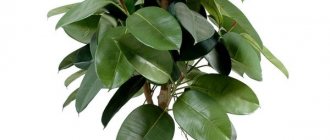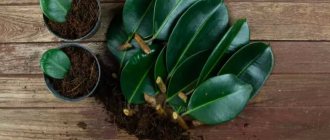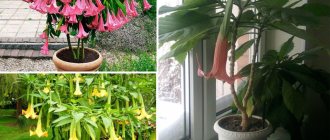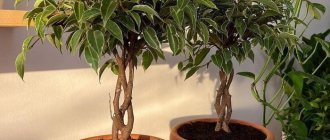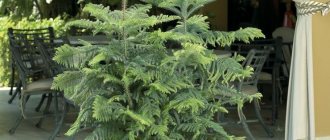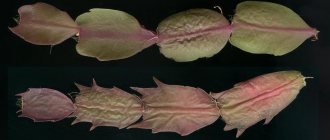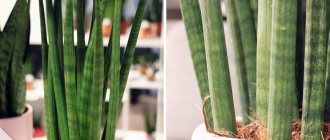Description and characteristics of ficus Tineke Elastica
Tineke is one of the varieties of the Ficus rubber (Elastic) species. In its natural habitat, the Indian and Indonesian tropics, it is cultivated to obtain natural rubber from the milky sap of the plant. In the open air it can reach a height of 30-40 meters. In indoor conditions, its growth is controlled by pinching, pruning and limiting the size of the pot. As a result, the ficus grows up to one and a half to two meters in height, and produces a lush crown.
The main advantage of the plant, beautiful decorative leaves:
- size - 25 cm in length and 15 in width;
- shape - oval with a pointed tip;
- color - green with a pronounced central vein.
On the sides, the leaf plates are decorated with an openwork, light edge, white, cream or light green. Thanks to it, the plant looks very picturesque.
Interesting. It’s not just decorativeness that has made Tineke a popular apartment dweller. The phytoncides it produces kill up to 40% of bacteria in the air. Leaves absorb toxic compounds: formaldehyde and phenol.
Varieties and decorative forms of rubber ficus
Ordinary dark green ficus elastica are almost crowded out of shelves and catalogs by a variety of decorative Dutch cultivars and forms:
- “Decora” is an olive variety with a bronze tint of shoots and young leaves;
- "Belize" - pink and white marbled variety;
- “Melany” is a small-leaved, densely bushy, capricious variety with a dark color and purple young leaves;
- "Schriveriana" - compact yellow-leaved spotted form;
- "Robusta" (Robusta) is a dark-leaved variety with a rich, almost black color and wrinkled leaves;
- "Burgundy" - a spectacular purple-leaved variety;
- "Tricolor" (Tricolor) - a variety with colored petioles and a play of pink and cream spots with several shades of a basic green tone on the leaves;
- "Tineke" - a capricious variety with anise and white spots;
- "Doescheri" - a narrow-leaved variety with an uneven creamy border and interesting pinkish undertones of marble patterns;
- “Black Prince” is a variety with an unusual grayish tint of dark green color;
- "Variegata" is a classic white-edged, unevenly variegated ficus;
- "Abidjan" is an unusual variety with red young leaves.
What to look for when choosing a plant?
In order for the ficus to take root in the house, you need to buy a healthy plant. Signs of disease are:
- spots or spots on leaves;
- insects on the stems or damage to the leaf blade (corroded edges, holes);
- black or dark brown roots visible through drainage holes.
On a note. Before purchasing, shake the plant directly with the pot or lightly run your hand over it; if the leaves fall off, it is better to choose another specimen.
You should buy ficus trees in spring or summer. This will make it easier and faster for him to adapt to his new home. It is better to give the choice to a young plant. It will be easier for him to adapt to new conditions. After purchasing, be sure to wash the leaves. Some sellers rub them with polish to make the plant look more attractive, but this negatively affects the health of the ficus.
How to plant from a leaf
To ensure the active development of the flower, you need to cut off the leaf with a small part of the stem.
If you plant only a leaf, you will not be able to get a full-fledged flower. It is important that the lower cut is in the center of the internode. It is recommended to cut leaves from the main trunk or side branches
The manipulation is carried out with gloves, since ficus juice is considered poisonous.
Planting material should be dried for 2 hours. Then it is recommended to roll the sheet into a tube and tie it with a thin thread. Place a small stick inside and stick it into the ground
It is important that it is several centimeters longer than the leaf. This support will help prevent horizontal development of the bush
To plant the plant, you should use purchased soil, which is recommended to be mixed in equal parts with humus and peat. Drainage should be placed at the bottom, since the ficus does not tolerate strong soil moisture. The leaf must be placed in the center, and the edges must be sprinkled with prepared soil.
Growing conditions
Ficus Tineke is unpretentious. The plant can survive: long-term lack of watering, insufficient lighting and nutrition.
However, with poor care, it will lose its decorative effect:
- growth will slow down;
- the crown will look scanty;
- the leaves are crushed and become monochromatic.
To avoid this, you should pay attention to Tineka, then the appearance of the ficus will delight others.
Temperature and humidity
Tineke come from the tropics, so they love warmth - 18-25 degrees. However, in winter you don’t have to be afraid of “catching” the plant, because:
- young ficus trees will easily survive a long cold snap down to +15-16;
- adult specimens are able to overwinter at temperatures of 5-7 degrees and even survive short-term frosts.
- in summer Tineke can withstand +30-40 degrees. However, if the temperature rises above +24, the plant must be sprayed twice a day.
Temperature changes can cause leaves to fall. However, the plant itself will survive the winter only if the roots remain warm. Therefore, a ficus pot cannot be placed on window sills or a cold floor. Teenekes do not take well to drafts, at any time of the year.
Indoor humidity should remain high regardless of the season. In winter, place a humidifier or a container of water in the room. If the house is warm enough (+18 and above), you can spray the plant to provide it with sufficient moisture.
Soil and soil
Ficus Tineke can be planted in ordinary universal soil, adding a little sand and peat to ensure looseness of the soil. You can also make your own substrate. To do this, mix in equal parts: garden humus, crushed peat, coarse sand.
Soil acidity should be slightly acidic or neutral. It can be measured with litmus strips. For this:
- A little soil is wrapped in thick cloth.
- Place in a glass with distilled or rain water (in proportions with the soil mixture 1:1);
- Leave for five minutes.
- Take out the package with soil;
- Quickly dip the litmus strip into water or squeeze one drop from a pipette onto it.
- Check the color with the indicator scale (if it’s orange or red, it’s acidic; if it turns blue, it’s alkaline).
You can reduce acidity using dolomite flour, chalk, ash (a few grams per pot). Increase - with peat, a weak solution of vinegar, citric or any other acid (a couple of drops). It is better to use peat, as there is less chance of acidifying the soil.
Lighting
Tineke is a light-loving plant, but on summer days direct sunlight can cause burns on the leaves. Young specimens are especially sensitive to bright light. Therefore, the optimal place for a ficus is the floor next to the window sill or even in the back of the room. On too hot days, the window can be shaded with a lowered curtain.
If there is a lack of light, the plant will live and even develop, but will lose its decorative effect:
- the lower leaves will turn yellow and fall off;
- the light edge will turn green;
- the stem and branches will begin to stretch.
When these symptoms appear, the plant should be moved closer to the window and additional lighting should be provided.
Important. In order for the crown to develop evenly (the branches do not stretch in one direction), the pot with the plant must be turned one or two centimeters every 7-10 days.
Where to place the plant
Important details:
an unpretentious flower does not tolerate frequent movement from place to place. For this reason, you need to immediately decide on the optimal area for placing the flowerpot; the plant tolerates light shade well, but diffused light has a positive effect on the flower. It is permissible to be exposed to sunlight for a short period of time (no more than 1 hour a day and not in the very heat; the ficus can be placed even at the northern window, but then you will have to be away from drawn curtains and thick curtains; the room needs to be ventilated, but drafts are of little use
The plant is quite strong, but gusts of wind and cold air are in any case undesirable; It is important that the rubber ficus be well lit during the day. If the rule is violated, the plant slows down, the leaves fall off, the internodes lengthen, and the decorative effect of the specimen decreases; you should not disturb the plant often: the tub with the ficus should not stand in the walkway so that household members do not touch the leaves when moving into the home.
Caring for a flower at home
Ficus trees do not require special care. Like other indoor plants, they need:
- periodic fertilization
- regular watering;
- replanting as it grows;
- treatment when diseases appear.
If you follow the rules of care, ficus grows quickly. Young specimens develop one leaf every 7-10 days.
Feeding and fertilizer
The main nutrients for plants are: nitrogen, potassium, phosphorus. The percentage composition of the components is indicated on each fertilizer package. Choose one that contains a large amount of nitrogen. It should be twice as much as potassium or phosphorus. Nitrogen is necessary for the development of green mass (side shoots and leaves). In small quantities, plants need: magnesium, calcium, boron and other minerals, as well as vitamins. Therefore, the best option is to purchase ready-made universal mixtures for vegetation (growth). They have a high nitrogen content.
When applying fertilizers, you should adhere to the following recommendations:
- during the period of active growth (spring, summer), nutrients are added once every couple of weeks;
- in winter - once every one and a half, two months;
- After the transplant there is a break. The plant has enough nutrients contained in the soil for about a couple of months.
All formulations are diluted according to the instructions. Some gardeners prefer to make the solution two to three times weaker than recommended to avoid burning the roots.
You can use natural fertilizers: cow, bird, and horse droppings are sources of nitrogen. They are dissolved in a proportion of 3-10 grams per liter of water. Ash – contains potassium, phosphorus and other minerals. It is added at the rate of one spoon per liter of water. You can simply sprinkle the ash on the damp soil along the edge of the pot.
Attention. Fertilizers are applied only after abundant watering. If the soil is dry, then fertilizing will have to be postponed. First moisten the soil, then add nutrients.
If the plant is exhausted or sick, you can do foliar feeding. Any fertilizer will do, but its concentration should be five to six times weaker than recommended for application to the soil. Foliar feeding is an effective solution, since after it the plant absorbs almost all the nutrients. However, constant use of the method leads to a slowdown in root development, with an increase in leaf mass. As a result, the ficus becomes unviable.
Watering
Tineke prefers moderate watering. It is necessary to avoid overmoistening and drying out the earthen coma. This leads to leaf fall. On average, ficus trees are watered once every three to four days, depending on the conditions in the house. Determining that it is time to give the plant a drink is quite simple. If the top layer of soil has dried out by one and a half to two centimeters, it needs to be watered.
In addition, the plant needs the following water procedures:
- spraying - once or twice a day if the plant is warm;
- removing dust from the surface of the leaves with a damp sponge - once a week;
- warm shower - once a month.
People from the tropics will gratefully respond to the abundance of moisture on the leaves. After all, in their native environment it rains almost every day.
Transfer
Ficus is transplanted every few years into a container two or three sizes larger than the current one (3-4 cm in diameter). It is best to focus on the plant itself.
When the pot becomes small:
- growth slows down or stops;
- the soil begins to dry out quickly, you have to water the plant almost every day;
- If you look into the drainage holes, you can hardly see the ground. All the space is occupied by roots.
Young ficus trees are replanted every year by transfer. To do this, the plant and the earthen lump are carefully pulled out of the pot so as not to damage the roots. The bush is slightly shaken, placed in a container with prepared soil and the free space is sprinkled with earth. When transplanting mature plants, you can trim the roots to slow down growth.
Important. Ficus does not like the roots to be waterlogged. Therefore, when planting, you need to provide a drainage layer 1/5-1/6 deep from the height of the pot. Expanded clay, broken tiles, gravel, and small stones are suitable.
Crown formation
Ficuses grow quickly, up to one meter in height per year. At the same time, they almost never produce side shoots without pruning. They begin to form a crown to obtain a tree when the plant reaches a height of about one and a half meters. Just cut off the top. After this, Tineke sends out lateral branches.
If you need a bush, then the crown is formed differently:
- shoots that grow outward from the bush are pinched when their length reaches 10-15 cm;
- do not touch the internal branches until the ficus has grown sufficient green mass;
- when the number of shoots increases so much that they shade each other, some of the shoots are removed.
After trimming, the “wounds” are wiped until the milky juice stops coming out of them, then sprinkled with ash or crushed coal.
Attention. The milky sap of ficus trees causes severe irritation if it comes into contact with the skin. Therefore, pruning is carried out with gloves.
Trimming
Ficus is a fast-growing type of indoor plant that grows quickly in comfortable conditions.
Annual pruning is done to achieve the following goals:
- reducing plant height;
- stimulation of the formation of new branches;
- formation of a lush crown of the required shape.
Before starting pruning, novice gardeners need to take into account that a change in the appearance of the plant occurs due to the formation of new shoots that emerge from the buds.
There are such types of kidneys as:
- apical;
- lateral.
Sometimes it is enough to simply remove the apical bud and the process of active growth of lateral shoots will begin. To remove shoots, you should use only sterile instruments that have a sharp cutting part. Excess juice should be quickly removed with a dry cloth. It is necessary to form a plant and renew its shoots in the first months of spring. To remove thin shoots, it is necessary to cut at a right angle, and for thick shoots, at an oblique. Botanists do not recommend removing aerial roots. These shoots should be directed towards the nutrient soil and, if possible, sprinkled with soil.
After pruning and active growth of branches, experts recommend trying to create a bonsai-style composition. To give the plant the required shape, it is necessary to use wire frames and tension systems.
The following video discusses in detail the care of rubber ficus.
Features of reproduction
Ficus trees are propagated by cuttings:
- Partially woody shoots are cut to obtain a cutting 10-15 cm long (at least 3-4 leaves). This is done with a well-sharpened knife.
- The upper leaves are trimmed, leaving 1/3 of the plate, carefully rolled, and the lower leaves are removed to reduce evaporation.
- Wash off the released juice.
- Place the cuttings in a container with water for 2-3 hours.
- The cut is dried.
After this, the cutting is placed in a jar of water. In this case, you need to ensure that the cut is above the surface of the liquid. You can immediately plant it in light, loose, moist soil. The container with the cuttings is covered with a cut-off plastic bottle or wrapped in polyethylene to create a mini greenhouse. This will increase the chances of rooting. You can begin to accustom Tineke to normal conditions after the appearance of the first young leaf. This is a sign that the plant has taken root and has roots.
Varieties of rubber ficus with photos and names
Varieties with monochromatic leaves:
Abidzhan - the length of the oval leaf blades is 25 cm, width - 18 cm. When young, the leaves have a dark burgundy, almost beetroot tint, then become deep dark green. The central vein below retains a burgundy hue.
Melanie is a miniature plant. The leaf length is about 15 cm, width - 8 cm. The leaf blades are shiny, dark green in color. The central vein is slightly depressed; on the reverse side they are reddish in color. It is noteworthy that a young bush is capable of branching even without pruning.
Robusta - the plant has a powerful rhizome, a thick trunk, large and fleshy leaves, which fully justifies the name of the variety (from the English robust - massive, strong, strong). The leaf blades are broadly oval in shape with a pointed tip, which is slightly bent downwards in the same way as the edges. The leaf color is dark green.
Burgundy is an elongated leaf, about 30 cm long and 10 cm wide. The shade is dark burgundy, the petiole is pinkish.
Black Prince - a leaf blade of the same length as the previous variety, the width is about 18 cm. The leaf blade is eggplant-colored, the central part is lighter.
Decora – the leaf plate is long (about 30 cm) and wide (about 20 cm). The leaves are almost heart-shaped in shape, forming a groove (both sides of the central vein are bent, like a half-opened book). The color of the leaves is rich green, the vein from the petiole is reddish, and above it is creamy.
Varieties with variegated leaf colors:
Belize - leaf length is 23-25 cm, width - 13-15 cm. The leaf blades are decorated with blurry spots of dark green, gray-green, yellowish and pink, the central vein is red-pink.
Schrijveriana - an ellipsoidal leaf stretches 25 cm in length and reaches a width of about 18 cm. The marble pattern decorating the leaf plate includes light green, grayish and beige spots. The initially light central vein becomes reddish.
Tineke - leaf blades are oval, reach a width of 18 cm, and extend 25 cm in length. The main shade of the leaf is green, it is mixed with cream and pistachio.
Sylvie - oval-shaped leaves. On a beige background (the shade of yellowed newspaper) there are light green spots-smears, directed from the veins to the edges. The vein is straw-colored, the petiole is green-pink.
Doescheri - long (about 25 cm) leaf blades hang in different directions, their width is about 10 cm. The leaf color combines light green, pistachio, and beige shades. The vein stretches as a uniform light yellow stripe.
Please note that when growing variegated varieties, it is necessary to maintain good lighting. From lack of light they may lose color.
Loading…
What diseases and pests are you susceptible to?
In indoor conditions, ficus rarely gets sick. It is mainly affected by insect pests that enter the house along with new plants or fly into the window in the summer. If woolly white spots appear on the leaves, cobwebs around the plant, or growths on the green parts, treatment with an insecticide is required.
The appearance of gray, black, white or yellow or brown plaque indicates a fungal infection. In this case:
- remove all affected leaves;
- the plant is sprayed with a solution of copper sulfate - 2 g, soda ash - 10 g, and laundry soap. You can use antifungal drugs - fungicides;
- reduce the intensity of watering, the number of sprays and humidity in the room.
These measures do not guarantee that the plants will recover, but they increase their chances. Fungi rarely attack ficus trees, but it does happen.
Sometimes the soil in which Tineke is planted can be affected by nematodes - small earthworms. They feed on plant juices, sucking them from the roots. Some species can parasitize stems. These pests slow down the growth of the plant, lead to its wilting and death. Symptoms: severe branching and rotting of small roots, the appearance of swellings and growths on the stems or root system, cracking of the bark (symptoms depend on the type of nematode). Treatment is the use of special means to combat this type of pest - nematicides.
3/5 — (2 votes)
Signs and superstitions
Many peoples treat ficus trees differently. The Chinese consider this plant a symbol of a strong family. In many Chinese cities, newlyweds are given this tree for their wedding for family well-being. In Thailand, ficus is considered a healing and magical inflorescence that helps cleanse a person’s aura and save him from many diseases. But on the territory of Russia, many are convinced that this culture is characterized by negative energy and attracts misfortunes to the houses where it grows.
Various superstitions are associated with the plant
Important! Many Slavs believe that ficus plants standing in pots at home have a negative effect on the love relationships of men and women. Ficus Ginseng is an evergreen plant that is characterized by strong immunity and vitality
Despite the fact that the crop is subtropical, it is actively grown artificially in countries with temperate climates. In order for the crop to begin to bloom in the spring-summer period, it is necessary to water it in a timely manner, feed it and transplant it into larger containers
Ficus Ginseng is an evergreen plant that is characterized by strong immunity and vitality. Despite the fact that the crop is subtropical, it is actively grown artificially in countries with temperate climates. In order for the crop to begin to bloom in the spring-summer period, it is necessary to water it in a timely manner, feed it and transplant it into larger containers.
Diseases
Diseases of rubber ficus occur as a result of errors in care or the appearance of insect pests. Common cases:
Yellowing of leaves, presence of brown spots. There are a number of reasons for this: drafts, floods, drop in temperature. Remove dry leaves and reconsider the conditions.
Crown shrinkage. Most likely, elastica lacks nutrients. There are 2 solutions - add fertilizing or replace the old, depleted substrate in the flowerpot with a fresh one.
Dropping leaves. If the phenomenon occurs periodically, then there is no need to panic. This is the norm for ficus. Otherwise, pay attention to the lighting.
Insect pests. If you notice sticky whitish spots or streaks on the leaves, then a possible source of trouble is a scale insect. It sucks the juice out of the plant, gradually weakening it.
Ficus is turning yellow - what to do? Main reasons, tips for restoration and treatment of indoor ficuses (110 photos and videos)- Sewage pumps: types, how to choose the right one
Ficus bonsai: secrets of growing and care at home. 140 photos of ficus varieties and video instructions for selecting conditions for growth
The only option to combat it is the use of chemical insecticides. This also applies to mealybugs and spider mites.
